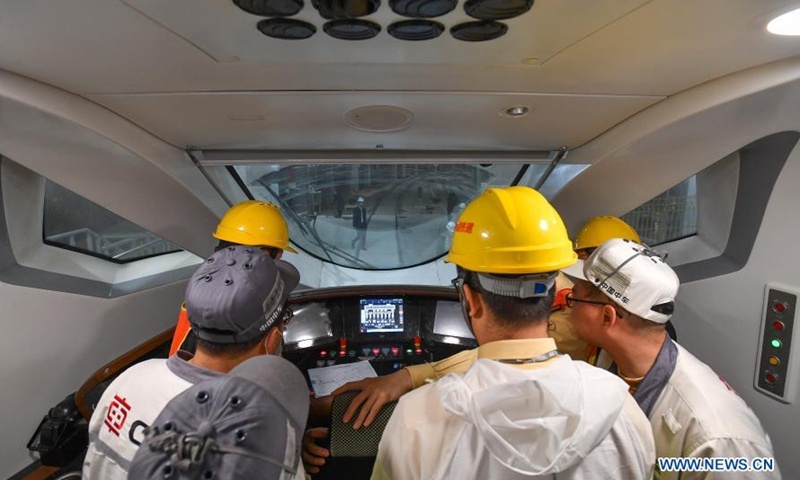
Technicians taking part in the hot-running test check a train of the Guangzhou Metro Line 18 in the cab in Guangzhou, south China's Guangdong Province, March 3, 2021. The electric train, with a maximum designed speed of 160 km per hour, carried out the first hot-running test in the small hours of Thursday morning, in order to conduct a comprehensive inspection of the subway power supply, signal, communication, line, and electromechanical system of the line.(Photo:Xinhua)
Scaling up the technological ladder and focusing on self-reliance on key technologies topped the agenda in the 2021 Government Work Report, delivered on Friday by Chinese Premier Li Keqiang.
Chinese analysts said the blueprints and work method detailed in the report could lead to a big step forward in the volume and structure of research and development spending and be conducive for China's efforts to narrow its gap with the US in technology.
Detailing some of the concrete targets to be achieved during the 14th Five-Year Plan (2021-25) period in the Government Work Report, Premier Li said the country will strive for above 7 percent annual growth in R&D spending, and will account for a higher percentage of GDP than that during the 13th Five-Year Plan period to keep up the country's momentum to scale the ladder of technology.
"Innovation remains at the heart of China's modernization drive. We will strengthen our science and technology to provide strategic support for China's development," Li said.
In the context of a brewing tech war with the US, the world's leading tech power, further input into R&D stays at the core of China's developmental bottlenecks, as the country is a determined manufacturing power that, in current times, can only be described as big but not strong, said Cong Yi, a professor at the Tianjin University of Finance and Economics.
"The world's No.1 industrial production capacity and the most complete industrial systems desperately need more fruits from original innovation so that it can move up the value chain," Cong told the Global Times on Friday.
Continued efforts to boost R&D spending will further narrow China's technology gap with the US, Cong said.
In an interview on the sidelines of the two sessions on Friday, He Lifeng, chairman of National Development and Reform Commission, China's top economic planning agency, told reporters that China will give full play to a new nationwide endeavor for core technologies in key areas, aiming to solve "stranglehold problems," and will introduce an open competition mechanism to select the best candidates to lead key research projects.
He pointed out that some major projects the country will keep focus on will include those beneficial to future development, such as quantum information, interstellar exploration, and energy security, food security, industrial and supply chain that are related to the long-term stability of the country.
More R&D investment lies at the core of tackling the stranglehold problems, experts said.
Zhou Shijian, a senior research fellow at the Center for US-China Relations at Tsinghua University, said the central government's pledge of more aggressive spending will definitely help beef up China's R&D expenditure as a percentage of GDP, potentially boosting that figure by 2025 to 2.8 percent - a level that the US enjoyed in 2019.
"However, given the level of insolence of US tech bully on China and the cutthroat nature of the tech sphere competition, this [level of input] is still not satisfactory," Zhou told the Global Times on Friday.
Zhou said while it is impossible for the US to decouple with China in the trade and economic sphere, it is entirely possible for the US to decouple with China in the technological sphere, making more spending a dire necessity for the sake of national security.
The US crippled the operation of Chinese telecommunication giant ZTE in 2018 with a ban of chips, and has suppressed the development of Huawei since 2019.
Zhou said China's R&D spending in basic research is still weak, which would put China at a significant disadvantage in the mid-to-long term technology race. More Chinese R&D spending goes into buying foreign technologies and technology application.
In 2019, when data of both China and the US were available, the US' R&D spending totaled $583.5 billion while China's reached $327.8 billion.
To put that into perspective, China, which has 67 percent of the US GDP in 2019, only has 56 percent of US R&D spending in that year.
Looking at basic research, China invested just $19.7 billion, compared with $105 billion in the US.
To boost spending in basic research, the central government's spending on basic research will increase by 10.6 percent in 2021, research institutes will have more say about how funds should be allocated, Premier Li said.
Researchers will be further relieved from undue burden to focus on scientific explorations like an undisturbed blacksmith spending years forging a perfect sword, Li said.
"Ideally, the catcher should spend more," Zhou said, predicting the Biden administration will continue a tech crackdown on China, as it was the Obama administration that started to contain China in tech in the first place.
Zhou also called for flexible tax mechanisms for scientists in vital sectors to ensure they have "real" high income.


